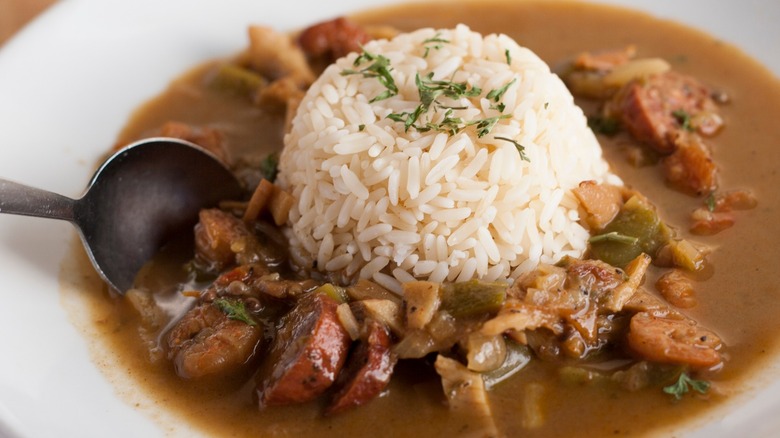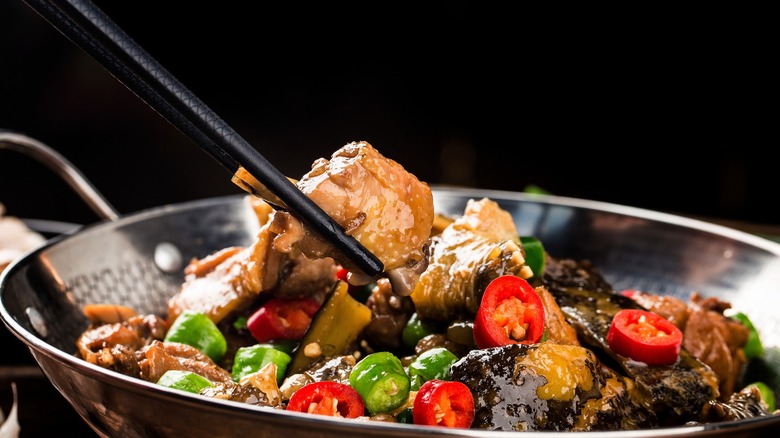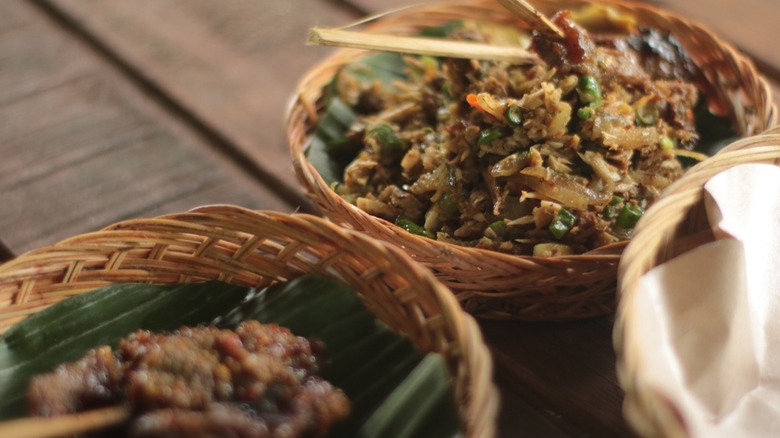What Does Turtle Meat Taste Like, And What Can You Do With It?
Even though turtle meat was once an everyday staple, it joined the ranks of former popular foods that aren't eaten anymore. Nevertheless, in many parts of the world, the protein is still consumed. As a result, one lingering question remains for those who haven't had a chance to taste turtle meat: What does it taste like, and how can it be prepared?
Well, turtle meat, according to the testimony that Chef David Gooch provided to the Los Angeles Times, can be depicted as a cross between pork and alligator, which is why the two proteins were used as a substitution in mock turtle soup. Nonetheless, putting Gooch's illustration aside, some have offered a broader descriptive spectrum of its flavor.
For instance, in an interview with Saveur, Ricky Crouch — a logger by trade who happened to take the writer on a traditional turtle (or cooter) hunt in a remote corner of Virginia– exemplifies the protein as a holy amalgamation of a variety of distinctive, flavorful meats, such as goat, chicken, fish, shrimp, beef, pork, and goat, citing old folklore as an explanation, "They say the Lord made the world in seven days, and he had a whole bunch of scraps left over. With those, he fashioned the cooter."
However, others — like Chef Cody Carroll (per The Takeout) — admire the meat for its mouth feel and offer more details. He said, "Turtle has the advantage of having an incredible meaty, beefy flavor with an extremely unique texture...think alligator or squid."
Considering turtle meat's flavor, there are tons of applications
Since the profile of turtle meat encompasses several different tastes, it's pretty versatile in cooking. For example, it's a common component in Cajun cuisine and can be found in various recipes for gumbo, sauce piquante, or this Creole snapping turtle soup. Moreover, it has been used unorthodoxly, like in Chef Justin Devillier's turtle chili. Still, the protein's applications go way beyond the cuisines of the southern United States.
China is deemed the world's biggest eater of turtle meat, and in doing so, they've accumulated a sundry of dishes revolving around soups and stews, curries, stir-frying, deep-frying, and grilling. Either way, there's also an assortment of recipes from other regions like the Amazon and the Caribbean, like the Cayman Islands, which includes the meat as part of its national cuisine and houses one of the largest turtle farms. So whether you're enjoying a Peruvian zarapatera (a hearty soup with green plantains and ground turtle meat) or a turtle burger in the Caymans, there are dozens of ways to prepare the protein.
Some things to consider about turtle meat
If you decide to try turtle meat, some things should be noted. First, the protein, especially if caught, can be intense like other wild game, so a citrus marinade might be the best way to remove some harsh flavors. Moreover, and more importantly, consuming turtle meat comes with controversy, regardless of whether they're farmed-raised.
The Cayman Islands and China have garnered a contentious reputation, depending on who you ask, regarding the protein's consumption. On the one hand, several opponents have suggested that the practice destroys ecosystems and endangers the world's turtle populations. Moreover, farming facilities, like the Cayman Turtle Centre, have been criticized for their methods. According to a report by The Ecologist, over 9,500 turtles are being raised in captivity that deal with overflow, illness, and in some apparent cases, are compelled to eat each other to survive. Yet, the approach is also viewed by others as a viable conservation solution. A scientific study published in The Science of Nature asserts that their findings suggest "...that the long-term survival of distinct genetic lineages and species can only be assured when an upscale market segment...is established."
Nevertheless, not everyone is convinced. Studies by the Animal Society Institute examined how humanity has impacted turtles. Still, turtle meat is a diverse resource full of complex flavor profiles that provide an adequate substitution for dishes that commonly utilize pork, beef, or seafood, making it a significant component (mainly because of its texture) for braises, grilling, frying, simmers, and roasting.


